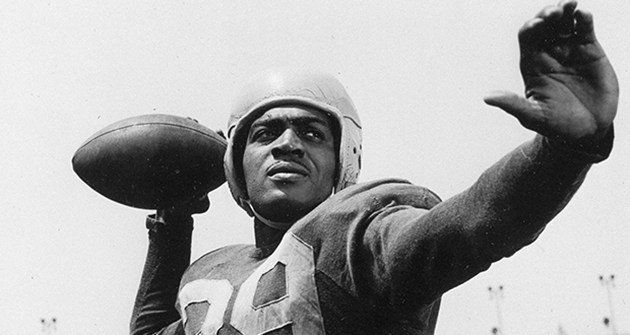1934 AND THE BLACK PLAYER BAN
- Cameron Rivers

- Nov 22, 2017
- 4 min read

Imagine turning on your television on a Sunday night, getting ready to watch the big game between the Dallas Cowboys and Philadelphia Eagles and during the player introductions no black players come running out of the tunnels. That would be impossible in 2017 with over 70% of the players of the National Football League being Black, so let's get in the hot tub time machine, and go back in time.
Between the years of 1934 and 1946 where all the black football players in the NFL vanished from thin air. So what happened?
In 1932 West Virginian and known bigot, George Preston Marshall founded the Boston Braves. Marshall didn't waste anytime implementing his racism into the organization when in 1933 he renamed the the franchise the Redskins." By the year 1937 Marshall moved The Redskins from Boston further south to Washington DC, a segregated city. Marshall with the assistance other NFL owners throughout the league helped broker a league wide ban on all Colored football players. This "ban" wasn't an official rule of the NFL but rather it was a gentleman’s agreement to no longer sign or draft any blacks into their league.
You could almost say that the league...*cough cough* black.... balled ....them? COLIN KAEPERNICK ON A TEAM YET? In the previous decade, 1920's, the first black quarterback in NFL history Fritz Pollard started to notice football teams were signing black all-American players only to gain fan support and recognition, because they were better athletes than their white counterparts. That all took a twist when after gaining popularity in the 1930’s, the NFL were no longer interested in signing black football players coming out of college.
During the Great Depression it was looked as a bad PR move to hire a black man while so many whites were out of jobs. NFL owners, much like their Major League Baseball counterparts, predictably denied the idea of a "racial band".
George Halas of the Chicago Bears declared to sportswriter Myron Cope in 1970 that there had been no unwritten exclusionary agreement,"in no way, shape, or form." Tex Schramm of the Los Angeles Rams did not recall a gentleman's agreement but did speak of the lack of Black players being signed; "You just didn't do it—it wasn't the thing that was done.";
George Halas attributed the lack of black players in the league to the lack of talent on the collegiate level. THE DEVIL IS A DAMN LIE. The 1939 UCLA football team, had four blacks. One was a transfer named Jackie Robinson. Ever heard of him? He was four-sport letterman who averaged 12.2 yards per carry. I heard he was pretty good at baseball too.... another great black college prospect was Kenny Washington, a teammate one year ahead of Robinson with a cannon for an arm.
Robinson declared Washington the greatest football he have ever seen. In 1940 Time magazine wrote that "he was considered by West Coast fans the most brilliant in the U.S. last year." Many regarded him as one of the best players in the history of college football, but when he graduated from UCLA, he was barred by NFL owners from entering the league.
He instead played for the Pacific Coast Professional Football League.
The racial climate of the 1930's undoubtedly contributed to lack of blacks in the NFL. While blacks were making a little progress towards racial equality under President Franklin D Rooselvelt's new deal, racism and hate towards Blacks still was a huge problem in America. I shouldn't have to remind you. That in the South, where over 2/3 of the black population resided, blacks were lynched, terrorized, and denied access to hospitals, restaurants, hotels and churches. So it is no surprise that racism and discrimination crossed over into sports.
Then the United States went to war. Although blacks were still second-class citizens by law, sharedservice began to break barriers—blacks, for instance, competed alongside and against whites on service football teams. When the All-America Football Conference launched in 1946 as a direct competitor tothe NFL, it distinguished itself in one significant way: There was no ban on black athletes. It was a very bold move, and forced NFL owners to lift their own ban.
Kenny Washington became the first black player signed to an NFL roster in the postwar era when he signed a contract with the newly relocated Los Angeles Rams in March 1946. He played three seasons and retired in 1948.
Also that year Woody Strode (Los Angeles Rams), Marion Motley (Cleveland Browns) and Bill Willis (Cleveland Browns) -- signed contracts and re-integrated professional football ... a year before Jackie Robinson did the same in Major League Baseball. Washington, Motley, Strode and Willis were later be known as the “Forgotten Four.
George Preston Marshall, meanwhile, proclaimed that he would never put a black player on his roster, a promise he would keep until 1962. He relented only when President John F. Kennedy threatened to nullify the Redskins'; 30-year lease on their stadium.


Comments